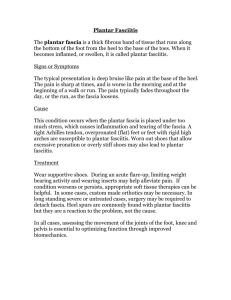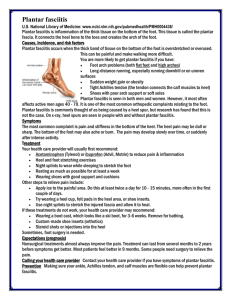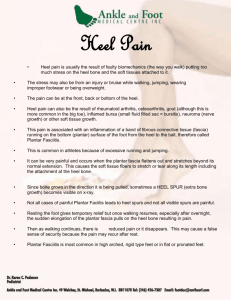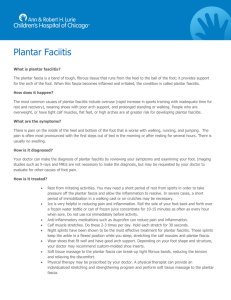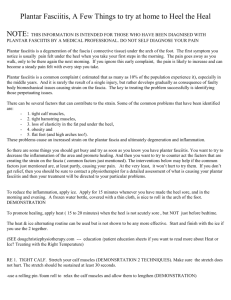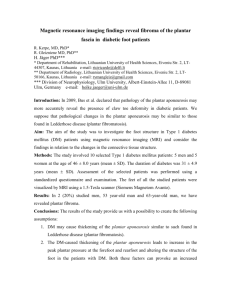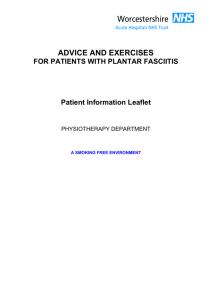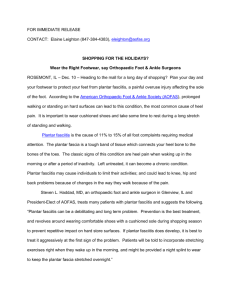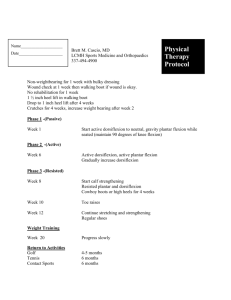My Poor Aching Feet
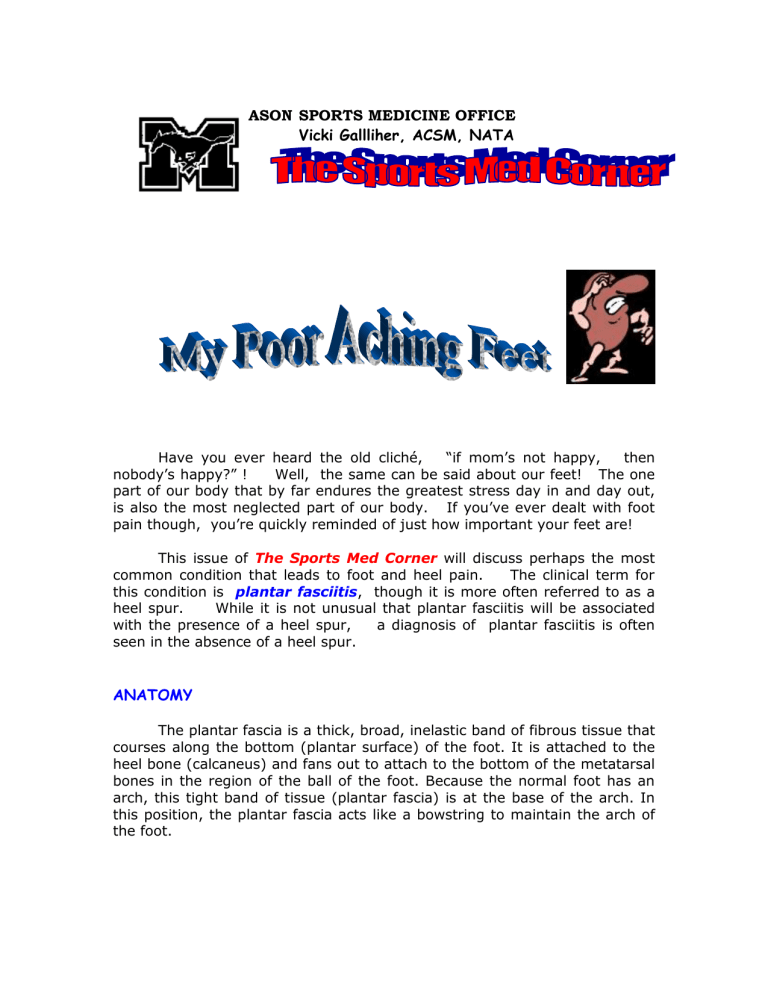
ASON SPORTS MEDICINE OFFICE
Vicki Gallliher, ACSM, NATA
Have you ever heard the old cliché, “if mom’s not happy, then nobody’s happy?” ! Well, the same can be said about our feet! The one part of our body that by far endures the greatest stress day in and day out, is also the most neglected part of our body. If you’ve ever dealt with foot pain though, you’re quickly reminded of just how important your feet are!
This issue of The Sports Med Corner will discuss perhaps the most common condition that leads to foot and heel pain. The clinical term for this condition is plantar fasciitis , though it is more often referred to as a heel spur. While it is not unusual that plantar fasciitis will be associated with the presence of a heel spur, a diagnosis of plantar fasciitis is often seen in the absence of a heel spur.
ANATOMY
The plantar fascia is a thick, broad, inelastic band of fibrous tissue that courses along the bottom (plantar surface) of the foot. It is attached to the heel bone (calcaneus) and fans out to attach to the bottom of the metatarsal bones in the region of the ball of the foot. Because the normal foot has an arch, this tight band of tissue (plantar fascia) is at the base of the arch. In this position, the plantar fascia acts like a bowstring to maintain the arch of the foot.
2
Figure 1: Lateral (Side ) View of Foot
Plantar fasciitis refers to an inflammation of the plantar fascia. The inflammation in the tissue is the result of some type of injury to the plantar fascia. Typically, plantar fasciitis results from repeated trauma to the tissue where it attaches to the calcaneus.
Figure 2: Plantar (Bottom) View of Foot
2
3
This repeated trauma often results in microscopic tearing of the plantar fascia at or near the point of attachment of the tissue to the calcaneus. The result of the damage and inflammation is pain.
If there is significant injury to the plantar fascia, the inflammatory reaction of the heel bone may produce spike-like projections of new bone called heel spurs. The spurs are not the cause of the initial pain of plantar fasciitis, they are the result of the problem. Most heel spurs are painless.
Occasionally, they are associated with pain and discomfort and require medical treatment or even surgical removal.
Plantar fasciitis (heel-spur syndrome) is a common problem among people active in sports, especially runners and tennis players. It typically starts as a dull, intermittent pain in the heel and may progress to sharp, constant pain. Often, it is usually worse in the morning or after sitting, and then decreases as the patient begins to walk around. In addition, the pain usually increases after standing or walking for long periods of time, and at the beginning of a sporting activity.
Often people who develop plantar fasciitis have several risk factors for doing so. They include:
Flat feet
High arched, rigid feet
Tight calf muscles
Increasing age and family tendency
Being overweight
Running on toes, hills or very soft surfaces (sand)
Poor arch support in shoes
Rapid change in activity level
If you don’t treat plantar fasciitis, it may become a chronic condition. You may not be able to keep up your level of activity and you may also develop symptoms of foot, knee, hip and back problems because of the way plantar fasciitis changes the way you walk. Most of us simply don’t realize how significantly the foot and its biomechanics can influence what occurs at the knee, hip and back.
Common Symptoms
Individuals usually describe pain in the heel on taking the first several steps in the morning, with the symptoms lessening as walking continues.
They frequently relate that the pain is localized to an area that the examiner identifies as the medial calcaneal tubercle. The pain is usually insidious, with no history of acute trauma. Many people state that they believe the
3
4 condition to be the result of a stone bruise or a recent increase in daily activity. It is not unusual for an individual to endure the symptoms and try to relieve them with home remedies for many years before seeking medical treatment.
Diagnosis
Even in this age of modern technology, the diagnosis of plantar fasciitis is based mainly on the medical history and clinical presentation. Direct palpation of the medial aspect of the calcaneus often causes severe pain (See figure at right). The pain is generally localized at the origin of the central band of the plantar fascia, with no significant pain on compression of the calcaneus from a medial (inside) to a lateral (outside) direction. Standard weight-bearing xrays of the foot reveal the biomechanical character of the hindfoot and forefoot. This typically refers to whether the foot tends to reside in a neutral
(level) position, or reveals a tendency toward supination (outside of foot tilts upward) or pronation (inside of foot tilts upward). Xrays may
Palpation of the medial calcaneal tubercle usually elicits pain in patients presenting with plantar fasciitis.
also show other osseous (bony) abnormalities such as fractures, tumors or rheumatoid arthritis in the calcaneus. However, xrays usually serve only as an aid to confirm a clinical diagnosis of plantar fasciitis.
Treatments
Symptoms usually resolve more quickly when the time between the onset of symptoms and the beginning of treatment is as short as possible. If treatment is delayed, the complete resolution of symptoms may take
6-18 months or more. Treatment will typically begin by correcting training errors, which usually requires some degree of rest, the use of ice after activities, and an evaluation of the patient’s shoes and activities. It is essential that you wear shoes that support the biomechanical nature
of your foot type – pronation, supination, or neutral. For pain, nonsteroidal anti-inflammatory drugs (e.g. aspirin, ibuprofen, etc.) may be recommended.
Next, risk factors related to how the patient’s foot is formed and how it moves are corrected with a stretching and strengthening program. If there is still no improvement, night splints (which immobilize the ankle during sleep) and orthotics (customized shoe inserts) are considered. Cortisone injections are usually one of the treatments of last resort, but have a success rate of
70% or better. The final option, surgery, has a 70-90% success rate.
4
5
Using an ice pack or ice bath on the painful area for about 15 minutes may relieve pain and inflammation after exercise and work. Massaging the foot in the area of the arch and heel before getting out of bed may help.
Stretching is very important. Approximately 85% of patients diagnosed with plantar fasciitis experience a significant decrease in pain and inflammation when they regularly engage in a stretching program for the foot and arch.
Stretching and Strengthening
To reduce pain and help prevent future episodes of discomfort, stretch the calves on a regular basis. A program of home exercises to stretch your
Achilles tendon and plantar fascia are the mainstay of treating this condition and lessening the chance of recurrence.
In this exercise, you lean forward against a wall with one knee straight and heel on the ground. Your other knee is bent. Your heel cord and foot arch stretch as you lean.
Hold for 10 seconds, relax and straighten up. Repeat 20 times for each sore heel.
5
In the second exercise, you lean forward onto a countertop, spreading your feet apart with one foot in front of the other.
Flex your knees and squat down, keeping your heels on the ground as long as possible. Your heel cords and foot arches will stretch as the heels come up in the stretch. Hold for 10 seconds, relax and straighten up. Repeat 20 times.
6
A similar stretch can be done by standing on a stair step with only the toes on the stairs. The back two-thirds of the feet hang off the step. By leaning forward to balance, the heel, Achilles tendon and calf will be stretched. Another stretch, similar in its effect, can be performed when standing where the heel is on the floor and the front part of the foot is on a wood 2x4. Some patients place a 2x4 in an area where prolonged standing is done (such as in front of the sink while washing dishes).
One other stretching exercise that typically yields significant relief involves the use of a softball (if you have a very small foot, use a baseball).
Simply place the softball on the floor, and while seated roll your foot back and forth over it. You should apply firm pressure downward on the ball while performing this exercise twice a day for about 5 minutes each time.
To strengthen the arch & foot muscles, do towel curls and marble pick ups. Place a towel on a smooth surface, place the foot on the towel, and pull the towel toward the body by curling up the toes. Or, put a few marbles on the floor near a cup. Keep the heel on the floor and use the toes to pick up the marbles and drop them in the cup.
Another excellent strengthening exercise is toe taps. Keep the heel on the floor and lift all of the toes off the floor. Tap only the big toe to the floor while keeping the outside four toes in the air. Next, keep the big toe in the air and tap the other four toes to the floor. Some jazzy music may help while doing this exercise !
6
7
Shoes and Splints
Wearing shoes that are too small may cause plantar fasciitis. Shoes with thicker, well-cushioned midsoles may help alleviate the problem. Running shoes should be frequently replaced as they lose their shock absorption capabilities.
Studies have shown that taping the arch, or using over-the-counter arch supports or customized orthotics also help in some cases of plantar fasciitis.
Orthotics are the most expensive option as a plaster cast is made of the individual’s feet to correct specific biomechanical factors. About 90 percent of people with plantar fasciitis improve significantly after two months of initial treatment. If your plantar fasciitis continues after a few months of conservative treatment, your doctor may inject your heel with steroidal antiinflammatory medications (corticosteroid).
Night splints, which are removable braces, allow passive stretching of the calf and plantar fascia during sleep, and minimize stress on the inflamed area.
According to several studies, approximately 80% of patients improved after wearing a night splint. It may be especially useful in patients who have had symptoms for more than a year.
If the pain persists, it may be necessary to run additional diagnostic studies to rule other, less common, causes of heel pain such as stress fractures, nerve compression injuries, or collagen disorders of the skin.
Rarely, surgical treatment is necessary. However, when the nonsurgical treatments have been tried and they have failed, surgery may be indicated for the relief of heel pain. Most of these surgical procedures can be completed on an outpatient basis in less than one hour.
Conclusion
Without our feet, it would be very difficult to manage all we do during the course of a typical day. Yet, how often do we pay attention to them? Just think of this … the medical care associated with a knee, hip or back condition is often time-consuming with regard to treatment & rehabilitation, not to mention very expensive! In comparison, simply taking the time to understand your foot’s biomechanics and ensuring that it is supported properly involves nothing more than determining what foot type you have
(neutral, pronating, supinating) and then purchasing the right shoes!
Take care of your feet & they’ll take care of you !
7
